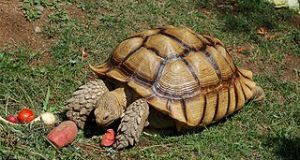 Red Eared Sliders (Trachemys scripta elegans) have been introduced worldwide and are believed to negatively impact many species. However, direct evidence concerning their affect on other turtles is scarce. A recent study involving Sliders, Spanish Terrapins (Mauremys leprosa) and European Pond Turtles (Emys orbicularis) has shed some light on the subject.
Red Eared Sliders (Trachemys scripta elegans) have been introduced worldwide and are believed to negatively impact many species. However, direct evidence concerning their affect on other turtles is scarce. A recent study involving Sliders, Spanish Terrapins (Mauremys leprosa) and European Pond Turtles (Emys orbicularis) has shed some light on the subject.
Hardy Invaders
It’s easy to imagine that introduced Red Eared Sliders would create problems for native European turtles. They are larger than many species favoring similar foods, breed rapidly, adjust well to human presence, and are very aggressive in the pursuit of food and basking sites.
I have noticed that Eastern Painted Turtles have declined in several habitats now occupied by Sliders, but am basing this on observation only, not study. Others voice the same concerns, but again have been unable to document just what, if anything, the Sliders are doing to nudge-out the natives.
Tadpoles are Easy Prey for Sliders
Writing in the journal Animal Behavior (V 80, N 3, Sept., 2010), herpetologists working on the Iberian Peninsula (Spain and Portugal) have determined that frog tadpoles, a common item in native turtle diets, hide when they sense native turtles in the vicinity but do not react to Sliders.
 Three of the four tadpole species tested stopped swimming when placed in water that had previously housed Spanish Terrapins and European Pond Turtles (both of which share the tadpoles’ habitat) but did not respond to the presence of Red eared Sliders (which have been introduced to the same habitats and are now well-established). Therefore, it is likely that Sliders can effectively capture the tadpoles, and may therefore out-compete native turtles for this important food source. Considering the rapidity with which Sliders breed, and the fact that both native species are already in sharp decline, feeding competition may well be a very serious concern.
Three of the four tadpole species tested stopped swimming when placed in water that had previously housed Spanish Terrapins and European Pond Turtles (both of which share the tadpoles’ habitat) but did not respond to the presence of Red eared Sliders (which have been introduced to the same habitats and are now well-established). Therefore, it is likely that Sliders can effectively capture the tadpoles, and may therefore out-compete native turtles for this important food source. Considering the rapidity with which Sliders breed, and the fact that both native species are already in sharp decline, feeding competition may well be a very serious concern.
I believe that this study highlights the importance of looking very carefully at every detail of an animal’s natural history. To the casual observer, it would seem that, in a “tadpole’s eyes”, a “turtle is a turtle”. After all, Sliders, European Pond Turtles and Spanish Terrapins are similar in appearance and habits. But, we now know, this is not the case….
I urge you to read, observe and record – important information is lurking everywhere, and we need to uncover it!
Further Reading
My Experience with Unusual Slider Habitats
Conservation Plan for European Pond Turtles
Cuatro Cienegas Sliders and Related Species
Spanish Turtle referenced from wikipedia and originally posted by Juan Lascorz
 That Reptile Blog – Reptile, Amphibian and Exotic Pet Care and Information
That Reptile Blog – Reptile, Amphibian and Exotic Pet Care and Information



this stuff ,
helped me out ,
on my grade 9 proj.
thanks ! 😀
Hello Lizzie, Frank Indiviglio here.
Thanks for taking the time to write in with the kind words, much appreciated. I hope you’ll check in from time to time; new articles are posted 3x each week. Please let me know if you need anything further.
Good luck in school,
Best regards, Frank Indiviglio.
Hi Frank.
Interesting information, as the Mississippi red-eared slider is out-competing native species of turtle here in Japan too. The Japanese pond turtle’s status in particular is suffering significantly.
I enjoy your articles.
Hello Andrew,
Thanks for the kind words. I’ve heard similar reports from friends in Japan, glad to have further confirmation from you. I saw Sliders at several sites last time I was in Japan (please see this article).
I took a quick look at your blog and see much of interest…will be sure to read the palm civet post more closely; they and related species have an interesting history of being moved about (genets introduced to Spain as well, I believe); I have many friends in Japan, have spent time there, mostly at zoos and aquariums (world’s best insect exhibits and aquariums, as you must know!) – had a chance to get behind the scenes and meet staff at several – so I’m looking forward to reading your posts. I hope to return – a zoo curator friend here in the USA, who was born in Fukuoka, returns there to study Japanese Giant Salamanders from time to time, and I hope to join him.
Best regards, Frank